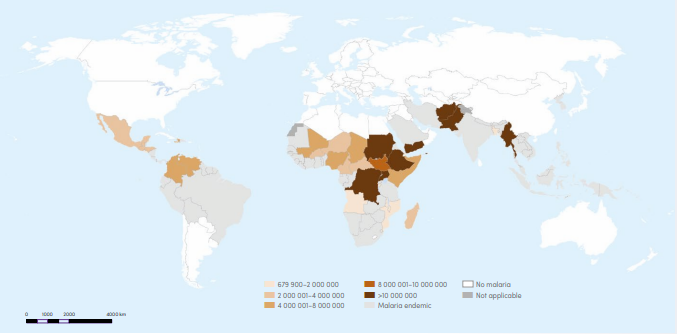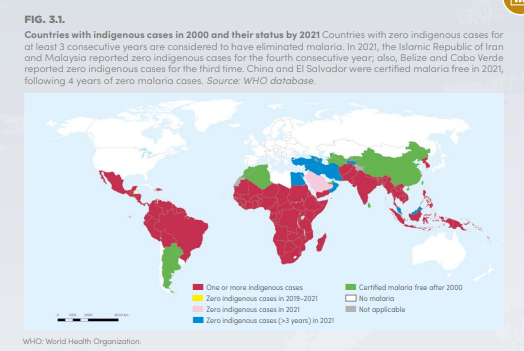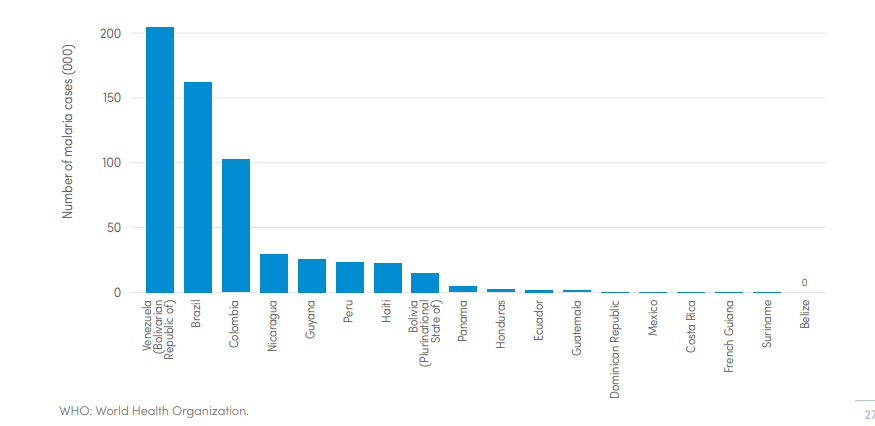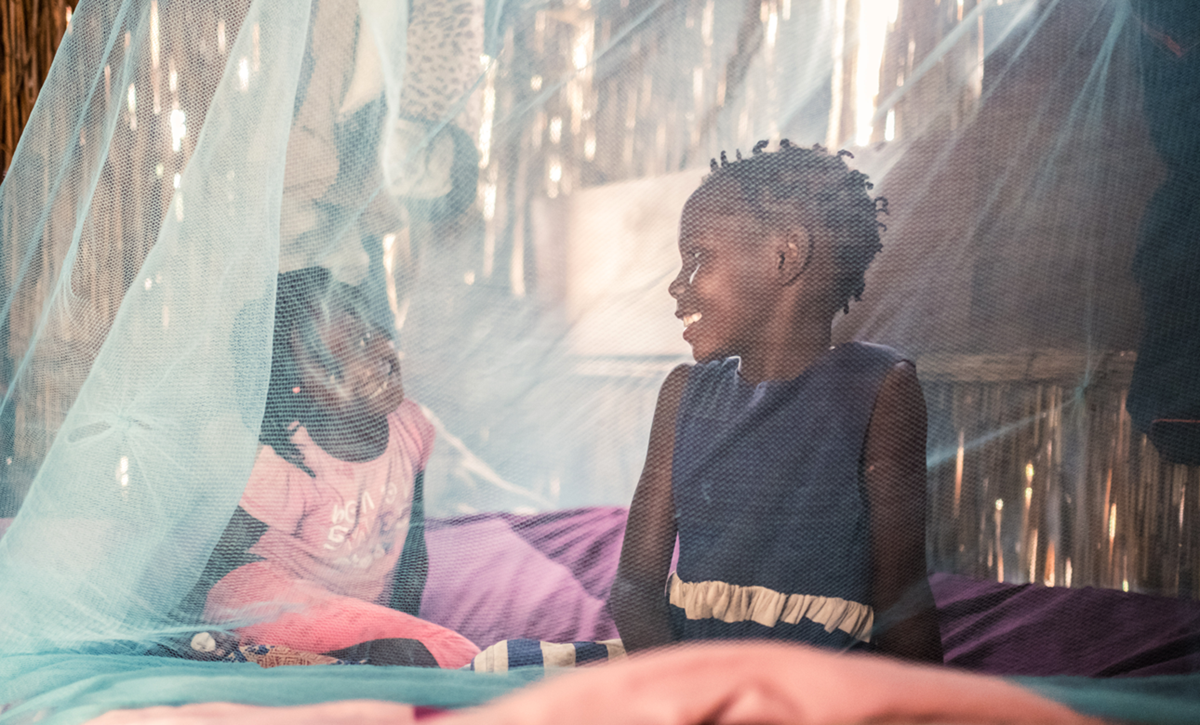Health Transformation Institute (HTI)
proactive health, care, consumer and
digital health transformation
Joaquim Cardoso MSc*
Chief Researcher, Editor and Senior Advisor
December 8, 2022
MSc* from London Business School
MIT Sloan Masters Program (European version)
EXECUTIVE SUMMARY
- There were an estimated 619 000 malaria deaths globally in 2021 compared to 625 000 in the first year of the pandemic. In 2019, before the pandemic struck, the number of deaths stood at 568 000.
- Malaria cases continued to rise between 2020 and 2021, but at a slower rate than in the period 2019 to 2020. The global tally of malaria cases reached 247 million in 2021, compared to 245 million in 2020 and 232 million in 2019.
- WHO recently launched 2 strategies to support countries in the African continent as they work to build a more resilient response to malaria:
(1) a strategy to curb antimalarial drug resistance and
(2) an initiative to stop the spread of the Anopheles stephensi malaria vector.
- Additionally, a new global framework to respond to malaria in urban areas, developed jointly by WHO and UN-Habitat, provides guidance for city leaders and malaria stakeholders.
- Meanwhile, a robust research and development pipeline is set to bring a new generation of malaria control tools that could help accelerate progress towards global targets.
Infographic
People in humanitarian need in malaria endemic countries as of December




ORIGINAL PUBLICATION (full version)

Despite continued impact of COVID-19, malaria cases and deaths remained stable in 2021
New data released today by the World Health Organization (WHO) show that countries around the world largely held the line against further setbacks to malaria prevention, testing and treatment services in 2021.
According to this year’s World malaria report, there were an estimated 619 000 malaria deaths globally in 2021 compared to 625 000 in the first year of the pandemic. In 2019, before the pandemic struck, the number of deaths stood at 568 000.
Malaria cases continued to rise between 2020 and 2021, but at a slower rate than in the period 2019 to 2020. The global tally of malaria cases reached 247 million in 2021, compared to 245 million in 2020 and 232 million in 2019.
Malaria cases continued to rise between 2020 and 2021, but at a slower rate than in the period 2019 to 2020. The global tally of malaria cases reached 247 million in 2021, compared to 245 million in 2020 and 232 million in 2019.
“Following a marked increase in malaria cases and deaths in the first year of the COVID-19 pandemic, malaria-affected countries redoubled their efforts and were able to mitigate the worst impacts of Covid-related disruptions to malaria services,” said Dr Tedros Adhanom Ghebreyesus, WHO Director-General.
“We face many challenges, but there are many reasons for hope. By strengthening the response, understanding and mitigating the risks, building resilience and accelerating research, there is every reason to dream of a malaria-free future.”

Strong national-level commitment key to success
Insecticide treated bednets (ITNs) are the primary vector control tool used in most malaria-endemic countries and, in 2020, countries distributed more ITNs than in any year on record.
In 2021, ITN distributions were strong overall and at similar levels to pre-pandemic years: of the 171 million ITNs planned for distribution, 128 million (75%) were distributed.
However, eight countries (Benin, Eritrea, Indonesia, Nigeria, Solomon Islands, Thailand, Uganda and Vanuatu) distributed less than 60% of their ITNs, and seven countries (Botswana, Central African Republic, Chad, Haiti, India, Pakistan and Sierra Leone) did not distribute any ITNs.
Seasonal malaria chemoprevention (SMC) is recommended to prevent the disease among children living in areas with highly seasonal malaria transmission in Africa.
In 2021, further expansion of this intervention reached nearly 45 million children per SMC cycle in 15 African countries, a major increase from 33.4 million in 2020 and 22.1 million in 2019.
At the same time, most countries succeeded in maintaining malaria testing and treatment during the pandemic.
Despite supply chain and logistical challenges during the pandemic, malaria-endemic countries distributed a record number of rapid diagnostic tests (RDTs) to health facilities in 2020. In 2021, countries distributed 223 million RDTs, a similar level reported before the pandemic.
At the same time, most countries succeeded in maintaining malaria testing and treatment during the pandemic.
Artemisinin-based combination therapies (ACTs) are the most effective treatment for P. falciparum malaria.
Malaria-endemic countries delivered an estimated 242 million ACTs worldwide in 2021 compared to 239 million ACTs in 2019.

A convergence of threats undermining efforts
Despite successes, our efforts face many challenges, particularly in the African Region, which shouldered about 95% of cases and 96% of deaths globally in 2021.
Despite successes, our efforts face many challenges, particularly in the African Region, which shouldered about 95% of cases and 96% of deaths globally in 2021.
Disruptions during the pandemic and converging humanitarian crises, health system challenges, restricted funding, rising biological threats and a decline in the effectiveness of core disease-cutting tools threaten the global response to malaria.
“Despite progress, the African region continues to be hardest hit by this deadly disease,” said Dr Matshidiso Moeti, WHO Regional Director for Africa. “New tools-and the funding to deploy these-are urgently needed to help us defeat malaria.”
Total funding for malaria in 2021 was US$ 3.5 billion, an increase from the two previous years but well below the estimated US$ 7.3 billion required globally to stay on track to defeat malaria.
Total funding for malaria in 2021 was US$ 3.5 billion, an increase from the two previous years but well below the estimated US$ 7.3 billion required globally to stay on track to defeat malaria.
At the same time, a decline in the effectiveness of core malaria control tools, most crucially ITNs, is impeding further progress against malaria. Threats to this key prevention tool include insecticide resistance; insufficient access; loss of ITNs due to the stresses of day-to-day use outpacing replacement; and changing behaviour of mosquitoes, which appear to be biting early before people go to bed, and resting outdoors, thereby evading exposure to insecticides.
Other risks are also rising, including parasite mutations affecting the performance of rapid diagnostic tests; growing parasite resistance to the drugs used to treat malaria; and the invasion in Africa of an urban-adapted mosquito that is resistant to many of the insecticides used today.

Key opportunities to accelerate progress
WHO recently launched 2 strategies to support countries in the African continent as they work to build a more resilient response to malaria:
- a strategy to curb antimalarial drug resistance and
- an initiative to stop the spread of the Anopheles stephensi malaria vector.
Additionally, a new global framework to respond to malaria in urban areas, developed jointly by WHO and UN-Habitat, provides guidance for city leaders and malaria stakeholders.
Meanwhile, a robust research and development pipeline is set to bring a new generation of malaria control tools that could help accelerate progress towards global targets.
Key opportunities include
- long-lasting bednets with new insecticide combinations and
- other innovations in vector control, including targeted baits that attract mosquitoes, spatial repellents and genetic engineering of mosquitoes.
- New diagnostic tests are also under development, as are next-generation life-saving medicines to respond to antimalarial drug resistance.
From late 2023 onwards, millions of children living in areas of highest risk of illness and death from malaria are also expected to benefit from the life-saving impact of the world’s first malaria vaccine, RTS,S.
Other malaria vaccines are in the product development pipeline.
According to the report, these opportunities cannot be fully exploited without intensified efforts to ensure that nobody is left behind.
Malaria-endemic countries should continue to strengthen their health systems, using a primary health care approach, to ensure access to quality services and interventions for all in need.
APPENDIX — TRENDS IN THE BURDEN OF MALARIA
Malaria cases
■ Globally, there were an estimated 247 million malaria cases in 2021 in 84 malaria endemic countries (including the territory of French Guiana), an increase from 245 million in 2020, with most of this increase coming from countries in the WHO African Region. In 2015, the baseline year of the Global technical strategy for malaria 2016–2030 (GTS), there were an estimated 230 million malaria cases.
■ Malaria case incidence (i.e. cases per 1000 population at risk) reduced from 82 in 2000 to 57 in 2019, before increasing to 59 in 2020. There was no change in case incidence between 2020 and 2021. The increase in 2020 was associated with disruption to services during the COVID-19 pandemic.
■ Between 2019 and 2021, an estimated additional 13.4 million cases were attributed to disruptions during the COVID-19 pandemic.
■ The proportion of cases due to P. vivax reduced from about 8% (20.5 million) in 2000 to 2% (4.9 million) in 2021.
■ Twenty-nine countries accounted for 96% of malaria cases globally, and four countries — Nigeria (27%), the Democratic Republic of the Congo (12%), Uganda (5%) and Mozambique (4%) — accounted for almost half of all cases globally.
■ The WHO African Region, with an estimated 234 million cases in 2021, accounted for about 95% of global cases.
■ Between 2000 and 2019, case incidence in the WHO African Region reduced from 373 to 225 per 1000 population at risk, but increased to 234 in 2020, mainly because of disruptions to services during the COVID-19 pandemic. In 2021, case incidence declined to 229 per 1000 population.
■ Cabo Verde reported zero indigenous cases for 3 consecutive years, ending the malaria epidemic.
■ The WHO South-East Asia Region accounted for about 2% of the burden of malaria cases globally. Malaria cases reduced by 76%, from 23 million in 2000 to about 5 million in 2021. Malaria case incidence in this region reduced by 82%, from about 18 cases per 1000 population at risk in 2000 to about three cases per 1000 population at risk in 2021.
■ India accounted for 79% of cases in the region. Sri Lanka was certified malaria free in 2016 and remains malaria free.
■ Between 2020 and 2021, there was an increase of 400 000 cases in the region, with over half of these cases being in Myanmar.
■ Malaria cases in the WHO Eastern Mediterranean Region reduced by 38%, from about 7 million cases in 2000 to about 4 million in 2015. Between 2016 and 2021, cases rose by 44% to 6.2 million.
■ Over the period 2000–2020, malaria case incidence in the WHO Eastern Mediterranean Region declined from 20 to 12 cases per 1000 population at risk. The Sudan is the leading contributor to malaria in this region, accounting for about 54% of cases. In 2021, the Islamic Republic of Iran had no indigenous malaria cases for 4 consecutive years and Saudi Arabia reported zero indigenous cases for the first time.
■ The WHO Western Pacific Region had an estimated 1.4 million cases in 2021, a decrease of 49% from the 3 million cases in 2000. Over the same period, malaria case incidence reduced from four to two cases per 1000 population at risk. Papua New Guinea accounted for nearly 87% of all cases in this region in 2021. China was certified malaria free in 2021 and Malaysia had no cases of non-zoonotic malaria for 4 consecutive years.
■ In the WHO Region of the Americas, malaria cases reduced by 60% (from 1.5 million to 0.6 million) and case incidence by 70% (from 14 to 4) between 2000 and 2021. The region’s progress in recent years has suffered from the major increase in malaria in the Bolivarian Republic of Venezuela, which had about 35 500 cases in 2000 and more than 482 000 cases by 2017. In 2020, cases reduced by more than half compared with 2019, to 223 000, and further in 2021 to 205 000 cases. This decrease was due to restrictions on movement during the COVID-19 pandemic and a shortage of fuel that affected the mining industry, which was the main contributor to the recent increase in malaria in the country. These restrictions may also have affected access to care, leading to a reduction in the number of cases reported from health facilities.
■ Estimated cases more than doubled in Honduras and Panama in 2021 compared with 2019. Over the same period substantial reductions in cases were seen in the Bolivarian Republic of Venezuela (–263 000), Brazil (–17 000), Colombia (–17 000) and Peru (–22 000).
■ The Bolivarian Republic of Venezuela, Brazil and Colombia accounted for more than 79% of all cases in this region.
■ Argentina, El Salvador and Paraguay were certified malaria free in 2019, 2021 and 2018, respectively. Belize reported zero indigenous malaria cases for the third consecutive year, ending the malaria epidemic.
■ Since 2015, the WHO European Region has been free of malaria
Malaria deaths
■ Globally, malaria deaths reduced steadily over the period 2000–2019, from 897 000 in 2000 to 577 000 in 2015 and to 568 000 in 2019. In 2020, malaria deaths increased by 10% compared with 2019, to an estimated 625 000. Estimated deaths declined slightly in 2021 to 619 000. Between 2019 and 2021, there were 63 000 deaths that were due to disruptions to essential malaria services during the COVID-19 pandemic.
■ The percentage of total malaria deaths in children aged under 5 years reduced from 87% in 2000 to 76% in 2015. Since then there has been no change.
■ Globally, the malaria mortality rate (i.e. deaths per 100 000 population at risk) halved from about 30 in 2000 to 15 in 2015; it then continued to decrease but at a slower rate, falling to 14 in 2019. In 2020, the mortality rate increased again, to 15.1, before decreasing slightly to 14.8 in 2021.
■ About 96% of malaria deaths globally were in 29 countries. Four countries accounted for just over half of all malaria deaths globally in 2021: Nigeria (31%), the Democratic Republic of the Congo (13%), the Niger (4%) and the United Republic of Tanzania (4%).
■ Malaria deaths in the WHO African Region decreased from 841 000 in 2000 to 541 000 in 2018, before increasing to 599 000 in 2020. Estimated deaths decreased again to 593 000 in 2021. The malaria mortality rate reduced by 62% between 2000 and 2019, from 148 to 56 per 100 000 population at risk, before rising to 60 in 2020 and decreasing again to 58 in 2021.
■ Cabo Verde has reported zero malaria deaths since 2018.
■ In the WHO South-East Asia Region, malaria deaths reduced by 74%, from about 35 000 in 2000 to 9000 in 2019. The number of deaths has remained the same over the past 3 years.
■ India accounted for about 83% of all malaria deaths in the WHO South-East Asia Region.
■ In the WHO Eastern Mediterranean Region, malaria deaths reduced by 45%, from about 13 600 in 2000 to 7500 in 2014, and then increased by 79% between 2014 and 2021, to 13 400 deaths. Most of the increase was observed in the Sudan, where more than 90% of cases are due to P. falciparum, which is associated with a higher case fatality rate than P. vivax cases.
■ In the WHO Eastern Mediterranean Region, the malaria mortality rate reduced by 60% between 2000 and 2009; however, since 2016, mortality rates have remained largely unchanged with a slight increase of 28% from 2.0 to 2.5 deaths per 100 000 population at risk.
■ In the WHO Western Pacific Region, malaria deaths reduced by 58%, from about 6200 cases in 2000 to 2600 in 2021; the mortality rate reduced by 67% over the same period, from 0.9 to 0.3 malaria deaths per 100 000 population at risk. Papua New Guinea accounted for more than 94% of malaria deaths in 2021.
■ In the WHO Region of the Americas, malaria deaths reduced by 64% (from 919 to 334) and the mortality rate by 73% (from 0.8 to 0.2). Most of the deaths in this region were in adults (78%). Malaria cases and deaths averted
■ Globally, an estimated 2 billion malaria cases and 11.7 million malaria deaths were averted in the period 2000–2021.
■ Most of the cases (82%) and deaths (95%) averted were in the WHO African Region, followed by the WHO South-East Asia Region (cases 10% and deaths 3%). Burden of malaria in pregnancy
■ In 2021, in 38 moderate and high transmission countries in the WHO African Region, there were an estimated 40 million pregnancies, of which 13.3 million (32%) were exposed to malaria infection during pregnancy.
■ By WHO subregion, west Africa had the highest prevalence of exposure to malaria during pregnancy (40.7%), closely followed by central Africa (39.8%), while prevalence was 20% in east and southern Africa.
■ It is estimated that, without a pregnancy-specific intervention, malaria infection during pregnancy in these 38 countries would have resulted in 961 000 children with low birthweight. In the 33 countries in which IPTp was implemented, an estimated 457 000 of these low birthweights were averted.
■ If all of the pregnant women visiting antenatal care (ANC) clinics at least once received a single dose of IPTp — assuming they were all eligible and that second and third doses of IPTp (IPTp2 and IPTp3) remained at current levels — an additional 55 000 low birthweights would have been averted in 33 countries with information on IPTp.
■ If IPTp3 coverage was raised to the same levels as that of ANC first visit coverage, and if subsequent ANC visits were just as high, then an additional 162 000 low birthweights would be averted.
■ If IPTp3 coverage was optimized to 90% of all pregnant women, an additional 265 000 low birthweights would be averted.
■ Given that low birthweight is a strong risk factor for neonatal and childhood mortality, averting a substantial number of low birthweights will save many lives.
ESTIMATED MALARIA CASES AND DEATHS IN THE WHO REGION OF THE AMERICAS, 2000–2021
- Between 2000 and 2021, in the WHO Region of the Americas, malaria cases and incidence declined by 60% (from 1.5 million to 0.6 million) and 70% (from 14.1 to 4.2 cases per 1000 population at risk), respectively (Table 3.6, Fig. 3.7a).
- Over the same period, malaria deaths and the mortality rate reduced by 64% (from 919 to 334) and 73% (from 0.8 to 0.2 deaths per 100 000 population at risk), respectively (Table 3.6, Fig. 3.7b).
- The Bolivarian Republic of Venezuela, Brazil and Colombia accounted for 79% of all cases in this region (Fig. 3.7c).
- Most of the cases in this region are due to P. vivax (71.5% in 2021). Progress in this region suffered in recent years because of a major increase in malaria in the Bolivarian Republic of Venezuela, which had about 35 500 cases in 2000, rising to over 482 000 by 2017.
- In 2020, however, cases reduced by more than half compared with 2019, from 467 000 to 223 000 cases, and then reduced further in 2021, to 205 000 cases.
Originally published at https://www.who.int on December 8, 2022.
Names mentioned
Tedros
Dr Matshidiso Moeti, WHO Regional Director for Africa.












